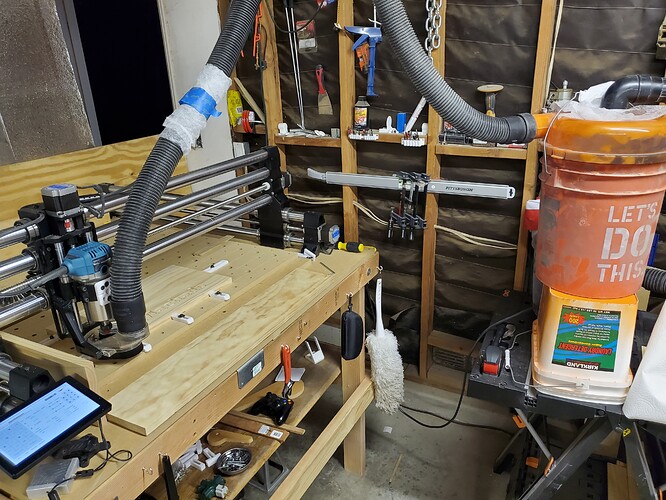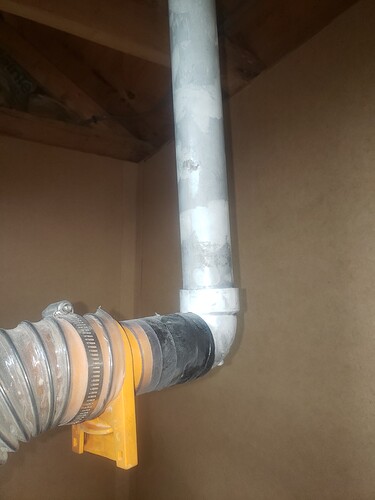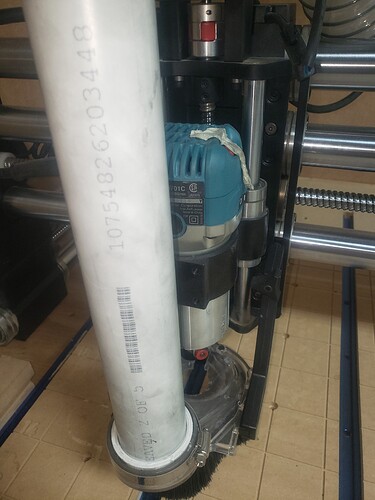You can run a bare wire and screw it through the plastic in various points and then ground one end to metal which is electrically grounded and it should help.
According to the testing he did in the video that OEW posted it does absolutely nothing to reduce the static no matter how many screws and wires you use.
-Alex
It won’t reduce it but it should discharge it elsewhere.
Not sure if you had a second to watch the video but in his demonstration it is only discharging the exact point that the dust hits each screw, so 99.99% of the static is still present and even adding hundreds of screws might take that down to 99.8%… I tend to agree.
But hey each to their own, if it makes you feel better/safer then by all means go for it! I’m an overengineered guy myself so I get the brick “shit house” approach… Trust me! 
-Alex
I live out on the planes of Colorado were it is high and very dry so I get it. What I have done to help the issue is anywhere I have a flex hose I buy the anti-static hose and ground that (It helps). If I did my dust collection again I would use the steel duct instead of PVC. I still get the crap shocked out of me when I use the shop vac. I am currently looking for a anti-static hose for it but then I will need to find an easy way to ground the shop vac hose when using it.
Short answer it acts like a capacitor.
A capacitor can be shunted to around to dissipate the charge that is built up in a capacitor. It is required if you work around large capacitors to discharge them several times before working near them.
From a US Navy technical manual:
SAFETY SHORTING PROBE
A representative shorting probe is shown in figure 1-4. An approved shorting probe is shown in
NAVSEA 0967-LP-000-0100, EIMB, General, Section 3.

Figure 1-4. - Representative safety shorting probe.
CAUTION
Capacitors and cathode-ray tubes may retain their charge for a considerable period of time after having been disconnected from the power source.
Always assume there is a voltage present when working with circuits having high capacitance, even when the circuit has been disconnected from its power source.
An approved type of shorting probe should be used to discharge capacitors and cathode-ray tubes individually.
When using the safety shorting probe, always be sure to first connect the test clip to a good ground (if necessary, scrape the paint off the grounding metal to make a good contact). Then hold the safety shorting probe by the insulated handle and touch the probe end of the shorting rod to the point to be shorted out. The probe end is fashioned so that it can be hooked over the part or terminal to provide a constant connection by the weight of the handle alone. Always take care not to touch any of the metal parts of the safety shorting probe while touching the probe to the exposed “hot” terminal. It pays to be safe; use the safety shorting probe with care.
Some equipments are provided with walk-around shorting devices, such as fixed grounding studs or permanently attached grounding rods. When that is the case, the walk-around shorting devices should be used rather than the safety shorting probe.
Ok so don’t judge me. But I’ve been having a rough time with static build up. I remembered looking up on how to get rid of static build up in clothe because something I was wearing once was sticking to me because of static. I read that if you use dryer sheets it would help with the build up. In my house, used dryer sheets are always around. Somehow a few sheets ended up in the garage. So I decided to attach it the hose and the dust collection bucket.
As of right now, I have surfaced two sides of a board (huge culprit) and currently 20 mins in on a 47 min carve. No static so far. Not sure why, or there is any truth to the dryer sheet helping with static but I have very little if any at this point. Call me crazy, or call it the placebo effect. But I’ll be using them from now on.
if it works  then cool.
then cool.
After a few months of use I have been noticing a lot of carbon dust from the routers brushes collecting on the outside of my dust collection system. Not sure what to do about this but I am sure it has to do with the static buildup on the pvc pipe. I did not think I had a static problem till I started seeing this. Any ideas?
Another reason to move to a spindle as soon as possible, I think.
There is not much you can do about dust collecting on the PVC. As for the router the brushes wearing so quickly is why I went with a spindle. I was lucky and found a 1.5k water cooled with a 65mm diameter but they are hard to find. You might try Ali-express. It will take about a month or two to ship from china


